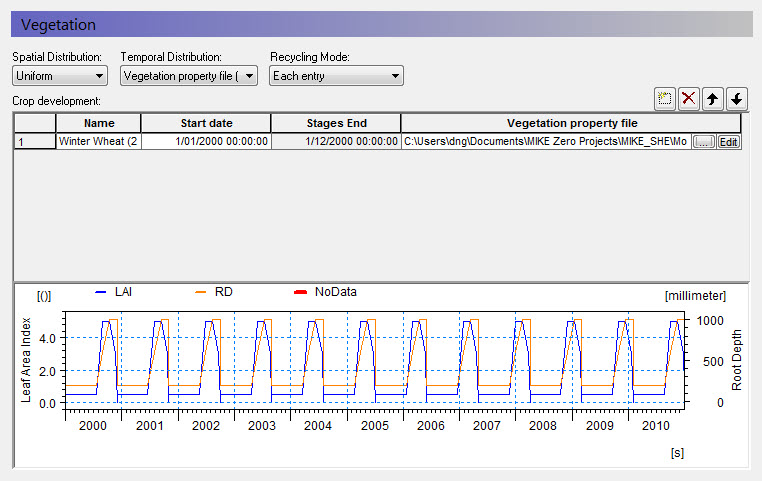

|
Vegetation |
|
|---|---|
|
Conditions: |
If Evapotranspiration selected in the Simulation Specification dialogue |
|
Grid Code |
|
|
Time Series EUM Data Units |
Leaf Area Index and Root Depth, or Vegetation Property File (see Vegetation Properties Editor (V1 p. 403)) |
|
dialogue Type: |
Special version of Time-varying Real Data |
There are three relevant time series parameters: the Leaf Area Index, the Root Depth and the Crop Coefficient, Kc. These parameters can be defined as constants, via .dfs0 files, or they can be defined from a Vegetation Properties file.
Using a Vegetation Properties file
The Vegetation Properties file typically contains a time series of the root depth and leaf area index for either one year or for the growing season. If you are using a properties file, then you have to specify the crop development schedule.
Name - This is the name of the crop or vegetation type in the properties file. This name must match exactly the name in the properties file. When you select the file name using the browse button, [...], you can select the vegetation item from a list of available vegetation types found in the file.
Start Date - The vegetation properties file typically contains information on a year or growing season basis - starting from Day 0. Thus, the Start Date is the calendar date for the beginning of the growing year or growing season. If data is missing in the time series, then the Leaf Area Index and the Root Depth are both assumed to equal zero. If the start dates overlap with the growing season information in the vegetation database, a warning will be issued in the log file that says the crop development was not over yet before the new crop was started. MIKE SHE will then start a new crop cycle at the new start date.

Tip: The times in the .etv file are instantaneous, which implies that the values between the entries are linearly interpolated. So, it is critical that you start your rotation scheme at Day 0. Otherwise, the subsequent values will all be interpolated from zero to the first rotation entry.
Recycling Mode
If you are using a Vegetation Property file, the Recycling Mode allows you to define a seasonal rotation to cover your simulation period - without having to specify a new line for each season. There are four recycling modes:
· None - if no recycling mode is defined, then you have to either specify enough lines to cover your simulation period, or that your development period in the .etv file is long enough to cover your simulation period.
· Each entry - each line will be repeated until the next start date. The last entry will be repeated until the end of the simulation
· Entire scheme - when the end of the scheme is reached, the entire scheme will start over. The scheme will repeat until the end of the simulation period. This mode requires that there are no gaps in the scheme.
· Entries, then scheme - each entry will be repeated until the start of the next entry. At the end of the scheme, the entire scheme will start over.
The Vegetation dialogue also includes a button for the Evapotranspiration Parameters, which are global stationary parameters.
Related Items
· Kristensen and Jensen method (V1 p. 427)
· The 2-Layer Water Balance Method (V1 p. 435)
· Vegetation Properties (V1 p. 250)
· Vegetation Properties Editor (V1 p. 403)